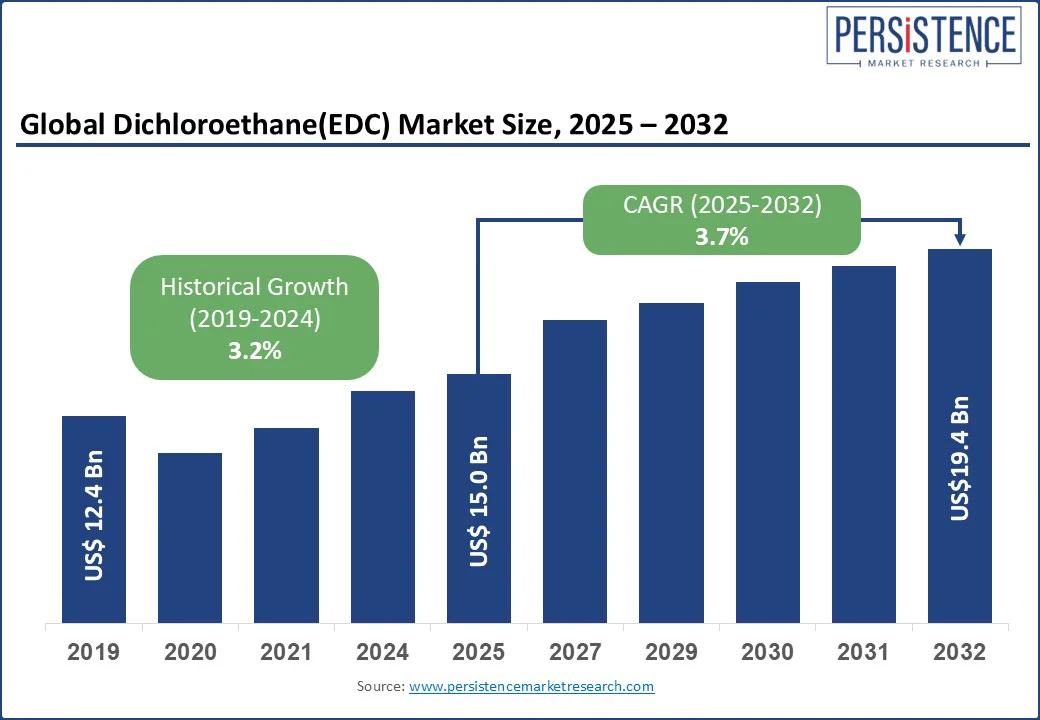ID: PMRREP3358| 172 Pages | 1 Aug 2025 | Format: PDF, Excel, PPT* | Chemicals and Materials

The global dichloroethane market size is likely to be valued at US$ 15.0 Bn in 2025 and is expected to reach US$ 19.4 Bn by 2032, growing at a CAGR of 3.7% from 2025 to 2032. Rising PVC demand in construction and automotive, fueled by urbanization, drives dichloroethane market growth. Technological advancements and pharmaceutical applications further boost expansion.
The global dichloroethane market is driven by increasing demand for vinyl chloride monomer (VCM) used in polyvinyl chloride (PVC) production, which is extensively utilized in construction, packaging, and automotive industries. Energy-efficient production technologies and the growing use of dichloroethane in ethylene amine manufacturing support market growth, especially in Asia-Pacific (China, India), North America, and Europe.

Rising Demand for Vinyl Chloride Monomer (VCM) and PVC
The demand for dichloroethane is strongly driven by its role in producing vinyl chloride monomer (VCM), which is almost entirely used to manufacture polyvinyl chloride (PVC). PVC's versatility and low cost make it essential in the construction sector for applications such as piping, siding, and window frames. According to the U.S. Environmental Protection Agency (EPA), nearly all vinyl chloride produced in the U.S. is used in PVC manufacturing, underscoring its importance in this value chain. Government infrastructure initiatives further illustrate this trend. For instance, the U.S. Census Bureau reported that total construction spending surpassed $2.1 trillion in May 2025, indicating a continued rise in PVC use-and thus in dichloroethane demand-as construction activity intensifies.
Advancements in Production Technologies
Technological advancements in dichloroethane production are significantly boosting market growth. Innovations such as improved chlorination techniques and energy-efficient reactors have enhanced operational efficiency while reducing environmental impact. Major industry players have adopted catalytic systems that cut energy consumption in vinyl chloride monomer (VCM) production, helping to lower overall manufacturing costs and carbon emissions. These improvements are especially vital in meeting evolving environmental regulations. For instance, under the European Union’s Industrial Emissions Directive, facilities are required to adopt best available techniques (BAT) to limit pollution. The European Commission identified optimized thermal chlorination and by-product recycling as part of BAT conclusions for large chemical plants, reinforcing the industry's shift toward cleaner and more sustainable production.
Health and Safety Concerns
Dichloroethane safety concerns are rising due to its classification as a Group 2B carcinogen by the IARC, indicating possible cancer risks. Manufacturers must comply with strict occupational exposure limits, such as OSHA’s 10 ppm and NIOSH’s 1 ppm guidelines, increasing operational costs. Compliance requires advanced ventilation, monitoring, and personal protective equipment. In regions with strict chemical safety laws, such as the EU (under REACH), usage is increasingly limited. These health risks and regulatory pressures reduce its adoption in sensitive applications and encourage investment in safer alternatives. As environmental and worker safety regulations tighten globally, managing dichloroethane exposure remains a critical challenge for manufacturers.
Expansion in Emerging Markets
Rapid industrialization in the Asia-Pacific and Latin America offers strong growth opportunities for the dichloroethane market. India’s construction sector, valued at US$ 650 billion in 2024, is growing at 6% annually, fueling demand for PVC and dichloroethane-based materials. In Latin America, Brazil’s packaging industry, worth US$30 billion, is driving market expansion. These high-growth regions present untapped potential for manufacturers to scale production, optimize distribution networks, and strengthen their presence in key downstream sectors such as infrastructure and consumer packaging.(Source: (IBEF))
Growth in Medical Applications
The pharmaceutical-grade dichloroethane market is expanding due to its critical role in drug synthesis and medical device manufacturing. The global pharmaceutical industry, valued at US$ 1.5 trillion in 2023, continues to grow steadily, increasing the need for high-purity solvents such as dichloroethane. This trend creates opportunities for companies such as Meru Chem Pvt. Ltd., which specializes in producing pharmaceutical-grade dichloroethane that complies with stringent quality and regulatory standards required by the healthcare and life sciences sectors.(Source: IQVIA).
Key players in the global dichloroethane market are focusing on sustainability and efficiency to stay competitive. Investments in low-emission and bio-based production help meet strict environmental regulations, while partnerships with construction and packaging sectors expand market reach. Companies such as Vynova Group prioritize cost-effective manufacturing to manage raw material volatility, and Formosa Plastics is expanding capacity in the Asia-Pacific region to meet growing demand.
Rising demand for VCM and PVC in construction, advancements in production technologies, and growth in ethylene amine applications.
Technical grade is a dominant type known for its widespread use in VCM production.
Ethylene amines, driven by demand in adhesives and coatings.
Asia-Pacific, holding the largest share in 2024, is led by strong growth in China and India.
They drive the adoption of low-emission and bio-based production methods.
Formosa Plastics, Occidental Petroleum, and SABIC lead through innovation and strategic expansions.
|
Report Attribute |
Details |
|
Historical Data/Actuals |
2019 - 2024 |
|
Forecast Period |
2025 - 2032 |
|
Units |
Value: US$ Bn |
|
2025 (E) |
US$ 15.0 Bn |
|
2032 (F) |
US$ 19.4 Bn |
|
Historical CAGR (2019 - 2024) |
3.1% |
|
Projected CAGR (2019 - 2024) |
3.7% |
|
Geographical Coverage |
|
|
Segment Coverage |
|
|
Competitive Analysis |
|
|
Report Highlights |
|
|
Customization and Pricing |
|
By Grade Type
By Application Type
By End-use
By Region
Delivery Timelines
For more information on this report and its delivery timelines please get in touch with our sales team.
About Author